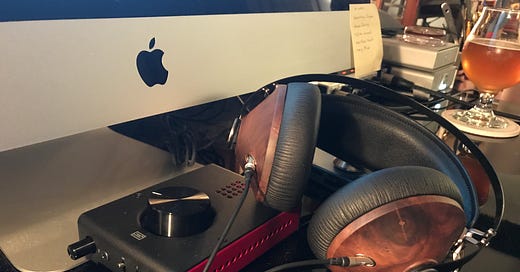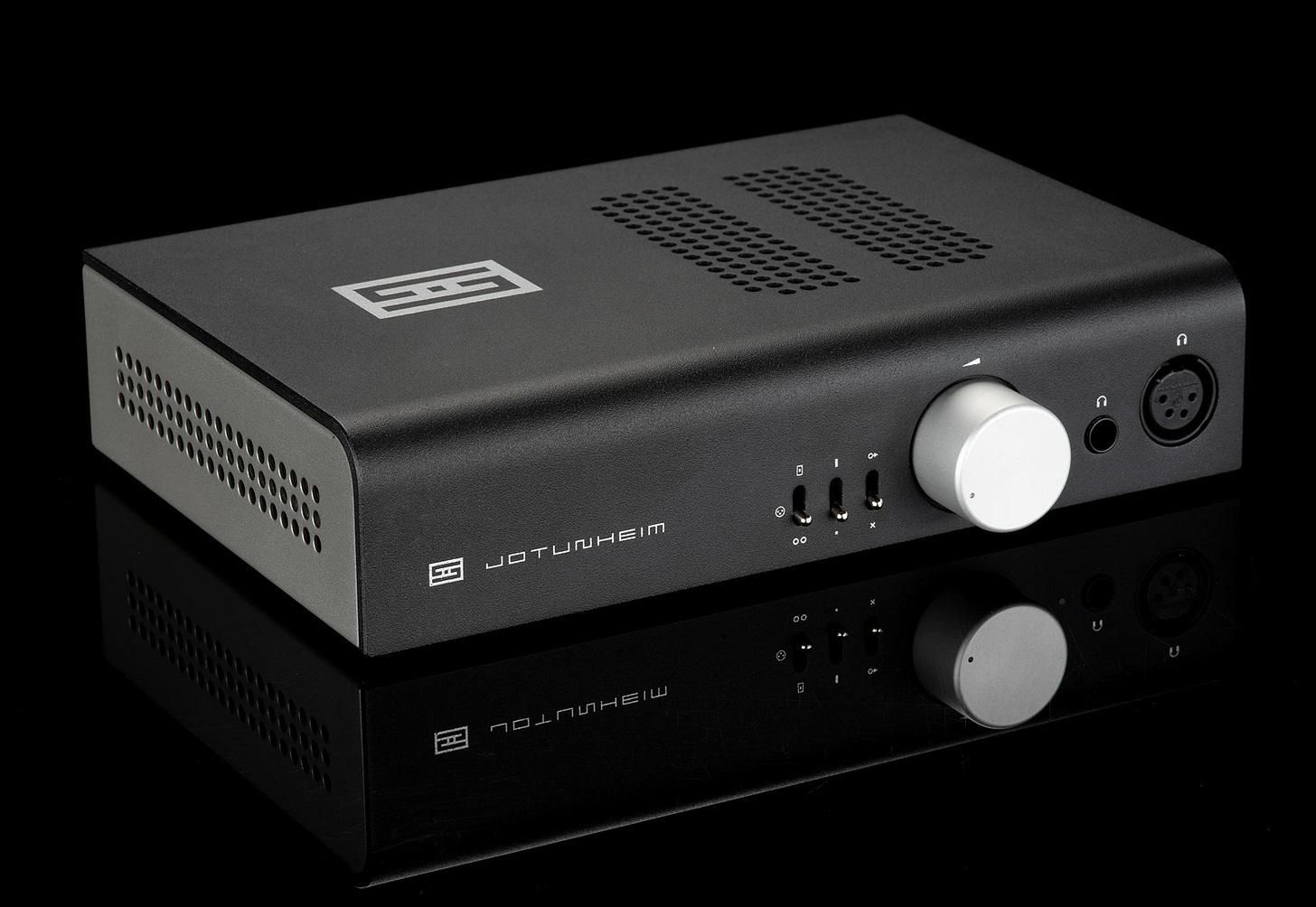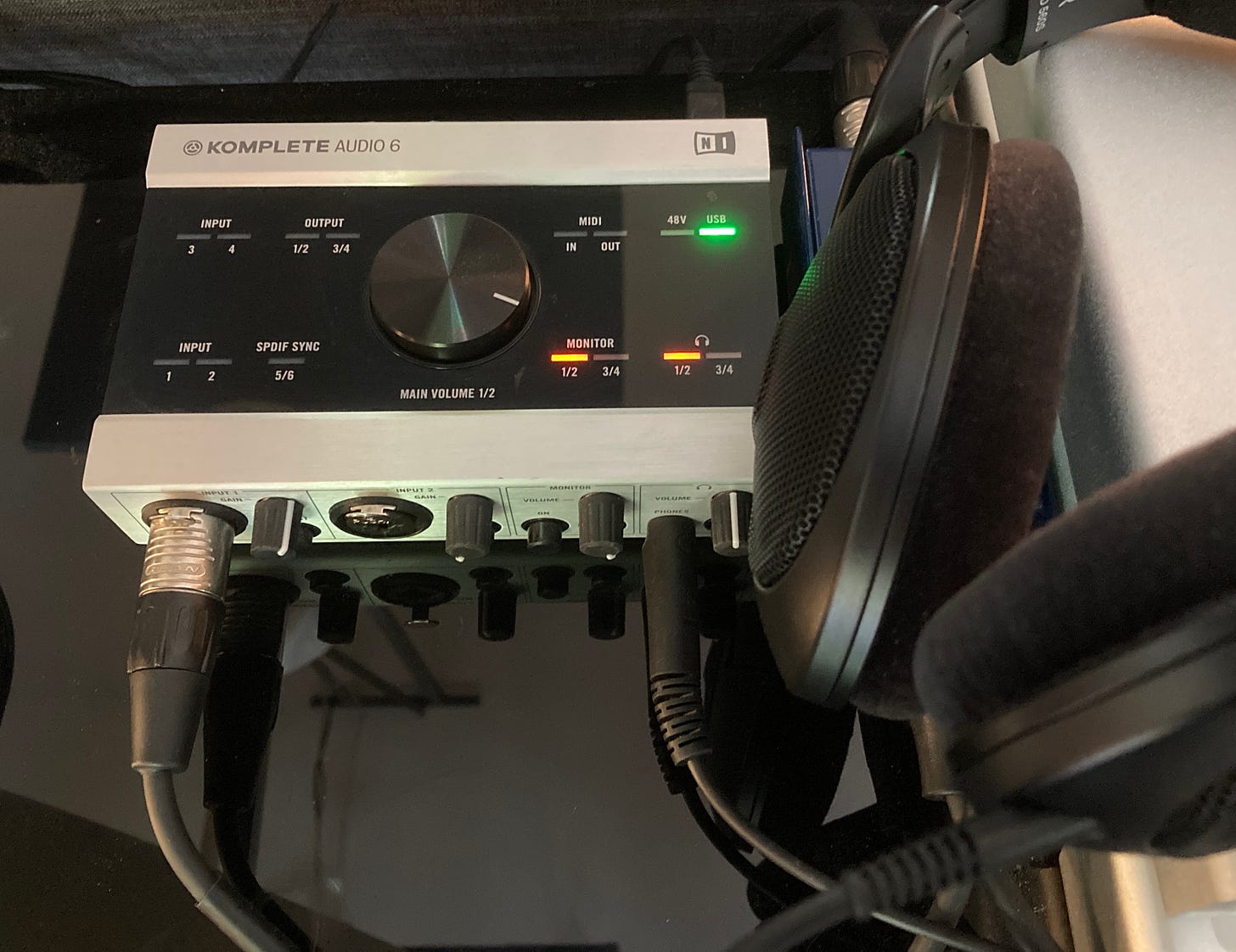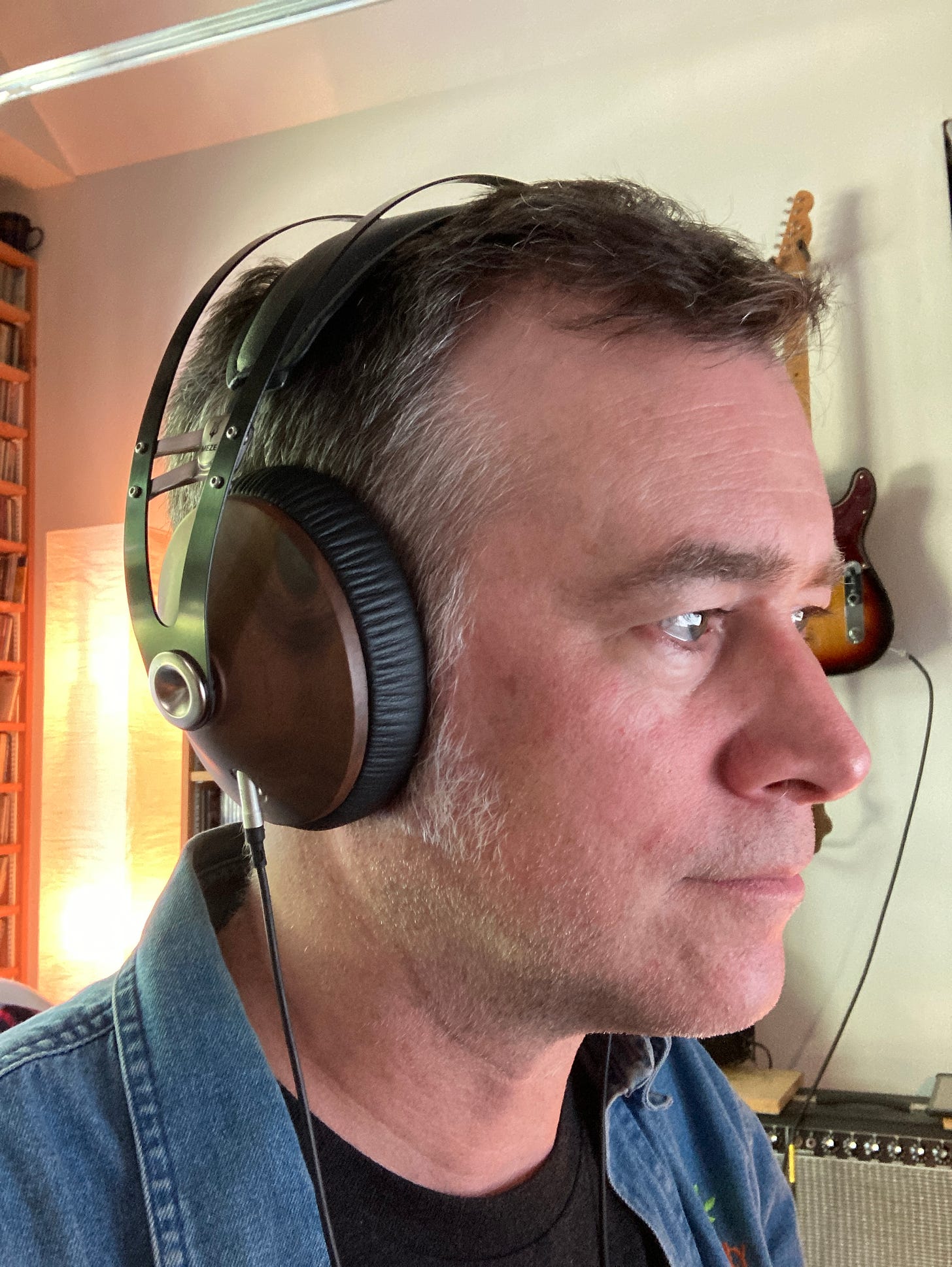Headphones are like pets. You swear you’ll only need one pair, and then you justify two, and soon you’re the cat lady from The Simpsons. I joke that I’m a Headphone American, because almost daily my work involves “cans” (as we pros call them, not really). I have four or five headphones for different practical applications and one pair for pure audio indulgence (seen above), which I’ll talk about last in this discourse on headphones. It’s a seductive world I have to tell you. There are whole websites and YouTube channels devoted to headphones, and I’ve wasted plenty of time there.
What are headphones good for and good at? The best line I’ve ever heard about them is that loudspeakers play the room, while headphones play your ears. Instead of drivers several feet from you pushing air from two sources that mix in the room to form a stereo sound field, headphone diaphragms pulse microscopically a few millimeters from your ear drum in a relatively sealed-off space. Those little pockets of isolation allow for complete stereo separation with control, detail and intensity. When they’re right, headphones create a moving, intimate sound experience and a transcendent bond with music.
Here, for fun, is one of the better headphone channel reviewers experiencing reportedly the most expensive headphone/amp system on Earth at almost $90,000.
This is silly money, which is of course not unheard of in the world of high end audio. But I share this to point out that actually, headphones are the audiophile’s low cost playground. Trying and buying loudspeakers and amplifiers for them is going to mean moving money around in the thousands (unless you’re one of these YouTube reviewer guys I guess). But headphones are a great hi-fi solution or hobby for the hundredaire. They’re almost essential for people who live in close quarters with others and who don’t have access to the square footage and privacy a loudspeaker system requires. The trick is to understand the basics of headphones and the dangers of getting ripped off, because no sector of audio has been flooded with overpriced crap more than this one. Headphones are hot in the marketplace these days too, quite like vinyl, and that’s good for the consumer (music lover) who knows a few things. This is a primer, by way of what I’ve bought and what I’ve learned.
First, here’s what I am not getting in to: earbuds or in-ear monitors and/or wireless headphones with on-board batteries, noise-cancellation and Bluetooth connection. I don’t have enough experience with either one, and I’d submit that those products, which are SO heavily marketed and promoted, require quite a lot of money to get an audiophile experience, though they can be great practical tools for portable listening. I very much enjoy my Tribit Bluetooth phones. They’re a steal.
I want to talk about and recommend traditional, cable-connected, over-the-ears headphones made with serious sonic reproduction in mind, which means brands like Sennheiser, Grado, Audio-Technica, HiFiMan (yes, that’s a company), AKG and a few others. All offer entry level phones in the $200-400 range, which is the sweet spot for quality and value and rationality. Maybe I’ll indulge in $1,000 headphones one day, but I’m happy with what I have and would rather keep upgrading my room stereo.
In making your budget for your awesome new headphones, I must tell you something important that you might not have known. Do not skip this step. You also need a dedicated, external headphone amplifier. Please don’t take this as bad news, because they’re not very costly and they’re essential to making the headphone money worth spending. You can not get an optimal, vividly exciting headphone performance by plugging your new phones into the audio jack of your computer or phone. It’s night and day, and here’s why.
You probably know that when you listen to streaming music on the web in any form, it comes into your device or computer as a string of ones and zeroes. That fast-moving digital signal can’t talk to your speakers without being converted into an analog signal. Analog means a flow of electrical pulses in a wire that tells the headphones how to fluctuate and push the air toward your eardrums. You would be correct in thinking that this conversion sounds complex and pretty important.
The external headphone amp plugs into your streaming computer’s USB port and does three things. It has a specialized circuit that does the Digital to Analog Conversion (DAC) more carefully and correctly than some little subroutine of your multi-tasking computer CPU. Its specially-designed amplifier boosts the analog signal to drive your headphones sensitively. And it has a dedicated volume knob, something you want close at hand and comfortable to use, instead of the awful click-drag-slide method of changing volume on a computer.
Headphones are a rather personal and subjective choice, and you can audition them at stores or buy and return them if need be (see the buyer’s guide at the end). I can save you time and uncertainty on the headphone amp though. Just buy Schiit. Yes, it’s pronounced like you think. And no, it’s not German, like I thought for years. It’s a whimsical American company run by an eccentric engineer named Jason Stoddard who set out to build and sell amplifiers that do the most for the least money. He wrote a long series of entertaining blog posts about creating and growing the company, and I’d point you to the chapter where his wife suggests naming it Schiit. “It would cut down on your marketing costs,” she tells him. And the consumers feel like they’re in on a joke, but the gear is no joke.
Here is a rundown of the choices Schiit offers for dedicated headphone DAC/amps, from least expensive to most. It’s an entertaining read, by the way, which is all too rare in audio. You can buy directly from them, which is also a sign of good audio commerce these days. Nothing wrong with dealers, but don’t distrust the direct to consumer manufacturers like Schiit, Zu or Emotiva. It’s part of the plan to save you money. I went with the Hel (shown at top), because it looks rad in my favorite red/black color scheme and because of the big volume knob on top. I won’t bore you (now) with my volume knob philosophy, but I can’t emphasize enough how important and satisfying it is to have to have a solid feeling volume knob, and this one holds up.
As soon as I plugged my Schiit Hel into my iMac’s USB port, it appeared as a choice in my outgoing audio menu. When I want to listen to my room stereo, I choose the Emotiva amp. When I work, I select a different USB box and headphone than I do for close music listening. I’ll say a word about that, because I think the distinction is useful in understanding the options and trade-offs involved in audio.
This is a Native Instruments Komplete Audio 6 interface, which is quite similar to the Schiit amps, except it’s two-way. It’s what I use to capture my desk microphone’s signal and convert it to digital for professional radio recording. The DAC works in reverse, analog to digital. Meanwhile, it’s converting digital to analog from the computer to my headphones, which are the Sennheiser 560S ($200) so I can monitor what I’m doing. Why would I use one good set of headphones for listening to my work audio and another for pleasure listening? Good question with a subtle answer. Because my focus at work is on the spoken word and spoken word mixed with music or ambient sound, I’m looking for a very neutral, transparent representation of what I’m doing. I find the Sennheisers great for that, while my audiophile phones, which I’ll describe here shortly, have more a more immersive and warm feeling. It’s like eating rich food, so there can be too much of a good thing. And as a practical matter, which is important to think about as you choose a phone, the Sennheisers let more air circulate around my ears, so they’re nicer and cooler to wear for long stretches of time. Comfort, fit and audio signature all matter.
That said, this line of Sennheiser headphones - the 500 and 600 series - are a gorgeous place to go for value hi-fi listening. I first heard Sennheisers killing time in a nicer airport with a fancy headphone store. I was able to plug my own phone in and play music I wanted to hear on the phones of my choice. In that moment, which I so clearly remember for its impact, I pulled up Liz Longley’s self-titled album (giving away roughly when this happened). The sparkly guitars, rich mid-bass and Longley’s glassy, velvety voice hit me hard. Total chills. A novel sensation. I had headphones as a kid, and I used them abundantly. But they were cheap and mediocre. To realize that truly sensational sound was a matter of just a couple hundred more dollars came as a revelation.
So that brings us to the end of this missive, and that’s where it started, with my deep listening headphones. I am proud to own a pair of Meze Audio 99 Classics, made of brass, maple and leather and not much more. They like to point out that they use no plastic or glue in the unit, only parts that can be removed and replaced. So the build quality is incredible for the price. Pronounced MEZay, it’s a Romanian company, and who doesn’t want to do a little something for Romania? Like Schiit, they’re serious about engineering to musical values of dynamics, quickness, impact, resolution and smoothness. They may offer more options now, but when I got into Meze, they offered two over-the-ear headphones, mine at $300 and their premium Empyrian at $3,000 a pair. (This is another tactic of some good audio companies, allowing you to sort of buy into Porsche or Mercedes-level engineering at a fair price.) Here’s a video of audio reviewing star Steve Guttenberg comparing the two Meze models side by side!
Anyway, my Meze 99s are amazing. Now I’m listening to the Ludwig Goransson soundtrack to the movie TENET, which is bonkers headphone music. It’s a vast melding of symphonic, electronic and digital sound-making. The score evokes the movie’s palindromic plot and mood, and on these Mezes, the deep bass thunder, the mellow low brass, the synthy overtones, the glistening edges of the treble are all fused in dreamy synchronicity. Now I’m trying vocal music, the new Blue Heron Suite from Sarah Jarosz. With its spare instrumentation, I can really hear inside the ensemble - Jeff Picker’s upright bass sounding woody and tall, tone-rich electric guitar by Jefferson Hamer and Sarah’s octave mandolin, with its fat midrange chords and silvery frosting. And of course her voice is the main event, with its clean watery flow and pure blue timbre. A quick adjustment with my volume knob and I’m floating in Sarah’s presence, divinely intimate. Of course you need to be happy with drum sounds, so listen carefully to bass drum and cymbals when auditioning headphones. I’m cueing up the live Trilogy 2 album with Chick Corea, Christian McBride and Brian Blade. Blade’s drums sound alive and whole. The cymbals decay naturally and the tunings of the tom-toms are clear. The bass drum is distinct from the low notes of the bass. This is why we listen.
Now go shopping! Here’s a new guide to affordable high-quality headphones from Pitchfork that makes for a great orientation. But get your Schiit together first.






